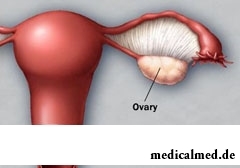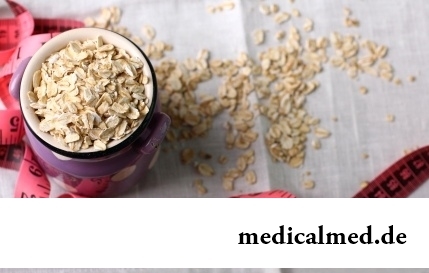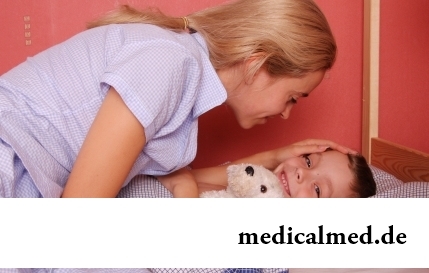





Oothecoma

The oothecoma represents a high-quality tumorous new growth in ovary tissue.
The pathological band space of a tumor is filled with various contents, most often liquid.
Young women of childbearing age treat risk group on incidence of an oothecoma, as a rule. In age category of women, is more senior than fifty years, the risk of formation of an oothecoma considerably decreases.
Types of an oothecoma
There are several different types of oothecomas:
- edometrioidny;
- follicular;
- mucinous;
- dermoid;
- paraovarian;
- oothecoma of a yellow body.
In most cases symptoms of an oothecoma of a yellow body are shown only on the one hand. Education walls reinforced. The tumor contains yellow liquid with blood impurity inside. The reasons of an oothecoma of a yellow body are covered that after an ovulation of a cell of a yellow body do not fill a follicle, it considerably increases in sizes and is filled with liquid contents.
The oothecoma of a yellow body and follicular cyst belong to new growths of functional character as form in the ovary as a result of the natural physiological processes proceeding monthly in a female body. The reasons promoting formation of these cysts is a hormonal failure in work of an organism. As a rule, similar oothecomas do not reach the big sizes, their education and growth proceed almost asymptomatically as do not cause to the woman of pain and discomfort. Often the disease is found absolutely accidentally, during planned survey by the gynecologist or as a result of ultrasonography.
At a paraovarian oothecoma symptoms of a disease develop in the appendage located over an ovary. The cyst represents the single-chamber tumor of a rounded or oval shape filled with transparent liquid contents. Thin, almost transparent, walls of a paraovarian oothecoma are penetrated by network of the smallest blood vessels. Age category of the women subject to this type of a disease, from 20 to 40 years. As a rule, the new growth has high-quality character and seldom covers pathological process an ovary.
Oothecoma symptoms

The absolute majority of oothecomas develops asymptomatically and is diagnosed accidentally when passing by the woman of routine gynecologic inspection or ultrasonography.
At increase in a tumor in sizes manifestation of the following symptoms of an oothecoma is possible:
- the stomach in a circle increases;
- there is pain of various intensity - with feeling of weight, a raspiraniye, to sharp, pristupoobrazny pains (the severe acute pain can testify to a rupture of an oothecoma or torsion of a leg of a cyst);
- the usual menstrual cycle is broken (if the tumor produces hormones).
Diagnosis of an oothecoma
In the diagnostic purposes and for purpose of the correct treatment of an oothecoma in medical institution hold the following events:
- general gynecologic survey;
- ultrasound examination of internals by means of transabdominal and transvaginal sensors (the ultrasonography method is the most painless and reliable today);
- the cyst contents puncture made through a back vault of the vagina (the method shown at the complicated oothecomas);
- laparoscopic inspection (in addition to the most exact diagnostic method of cysts and a possibility of a research of their contents, the laparoscopy at the same time is the medical procedure);
- laboratory blood test on contents of onkomarker in it;
- a blood analysis on hemoglobin level;
- a pregnancy test (for an exception of probability of an extrauterine pregnancy).
Treatment of an oothecoma
Choosing right tactics of maintaining the patient with new growths in ovaries, the doctor relies first of all on age of the woman and on a tumor ozlokachestvleniye risk degree. In an age group of women of reproductive age, making decision on operational removal of an oothecoma is discussed jointly and most deliberately as surgery takes all ovary together with an appendage.
Conservative treatment of an oothecoma is possible when origins of a cyst have functional character, the cyst has no tendency to a rupture of the capsule, suppuration and other complications.
Today for surgical removal of an oothecoma the laparoscopy method is used most often. Laparoscopic operation is most effective, painless and does not threaten further with postoperative complications.
At regular visit of a sunbed the chance to develop a carcinoma cutaneum increases by 60%.

The metabolism at each person proceeds in own way. However dependence between the speed of this process and disposal from superfluous in...
Section: Articles about health
For anybody not a secret that the modern person eats not as his ancestors. For the last 100 years in broad access there were absolutely new products which are result of use of the latest technologies in food production. Significantly changed спо...
Section: Articles about health
Within several decades of our compatriots convinced that the use of butter nasty affects a condition of coronary vessels. As a result the reputation of a product was impaired thoroughly a little, and many almost ceased to include it in the diet, having given preference "to safer" to vegetable fats. Meanwhile, the last researches showed that harm of butter for health is strongly exaggerated. But the product has a number of unique properties, to...
Section: Articles about health
Partial and the more so full loss of hearing significantly reduces quality of life. Difficulties with communication lead to loneliness and замкн...
Section: Articles about health
Antibiotics - - it is possible to call the chemical compounds suppressing growth of bacteria the break in the field of medicine which allowed to save mankind from many diseases incurable earlier: tuberculosis, plague, syphilis and many others. A contribution of drugs to rescue of people from...
Section: Articles about health
Transfusion of donor blood has almost century history. In spite of the fact that this procedure is quite usual for many people, process of blood donation is still surrounded with numerous myths. Today we aimed to discredit the most widespread of them....
Section: Articles about health
Cellulitis - very widespread cosmetic shortcoming which arises approximately at 80% of women sooner or later. Emergence ег...
Section: Articles about health
On the head of the person about one million hair follicles, or as they are called still, hair bulbs are located. At the time of the birth most of them is in the "sleeping" state, but within several weeks follicles become more active, and from them begin р...
Section: Articles about health
For the person who daily since morning gathers for work it is very important to wake up vigorous and ready by day of work. Actually, each of us experiences difficulties with this, at first sight, simple business from time to time. After night rest exert impact on a condition of an organism the weather which collected for several days fatigue, household and office problems, quality of a dream and many other factors....
Section: Articles about health
Bees – really unique beings. Practically all products of their life activity are used by the person. Since the most ancient times from...
Section: Articles about health
Life does not indulge the modern woman special emotional comfort and carelessness. The fatigue, troubles at work, misunderstanding in a family and various illnesses immediately affect a condition of hair and skin. And to look safe and attractive so хоч...
Section: Articles about health
The sclera and mucous membrane of an eye are intensively supplied with blood vessels which problem - to saturate nervous tissues of body with nutrients and oxygen. In a normality vessels are almost not noticeable, however at their expansion (owing to thinning of walls) become visible, painting a sclera in red color. Quite often red eyes - the signal of any trouble in an organism caused as external irritants, allergens, and diseases which need in about...
Section: Articles about health
The list of stereotypes of which, apparently, all know strongly includes following: British surely eat for breakfast овсянк...
Section: Articles about health
According to World Health Organization, every third inhabitant of Earth has excess weight, and every tenth has obesity. The reason of this phenomenon, according to specialists, roots in one not very comforting fact: most of people consume much...
Section: Articles about health
Producers of milk mixes for children assure: mixes are ideally balanced and adapted for needs of babies. If mother should raise artificially the kid owing to serious problems with health, to do nothing – it is necessary to feed with substitutes of milk. However pediatricians note that not seldom women without good reasons refuse feeding of the child a breast and pass to milk mixes. Common causes of such decision – the aspiration to leave quicker...
Section: Articles about health
There is an opinion that at low temperatures safety of products is ensured longer and better thanks to what the refrigerator considers...
Section: Articles about health
Weakness of an ankle joint – very widespread problem. Its existence is demonstrated by tendency to a podvorachivaniye of legs when walking on heels, frequent painful sprains, pain on average and anonymous toes even after small nagruzo...
Section: Articles about health
The endocrine system carries out extremely important role in a human body, practically all processes of life activity are regulated by it. Closed glands (hemadens) produce special biologically active agents – hormones which then get to a blood channel and are transferred to bodies addressees, or as they are called still, to target organs. Frustration of this mechanism are fraught with development of serious chronic pathologies....
Section: Articles about health
People know that thermal sources have salutary force long ago. Treatment by natural waters is one and...
Section: Articles about health
The winter swimming in open reservoirs called in our country by "winter swimming" – officially recognized sport and one of the most extreme ways of a hardening of an organism. This occupation has an old story and adherents in many countries. Are annually carried out...
Section: Articles about health
The way of life of people promptly changes from year to year: if about ten years ago the personal computer was not in each family, then today already very few people do without this device. Certainly, and children master the computer at full speed: they not only play on it games, but also study, and write school works, and search for necessary information....
Section: Articles about health
Many parents of children at the age of 2-4 years face excessively whimsical behavior of the child. The kid exhausts constant crying...
Section: Slideshow
It seems, quite recently you brought the baby from maternity hospital, but time flew by, and here it is already going to join the first in life children's collective. How to prepare the child for visit of a garden? What needs to teach him to facilitate process адап...
Section: Articles about health
Among a set of the perfumery and cosmetic goods which are released today the special group is made by the means containing antibacterial components. Such types of gels, shampoos, soaps, creams, lotions and other products are positioned by manufacturers as a panacea from all diseases caused by pathogenic microorganisms. The unlimited and uncontrolled use of similar means becomes result of trustfulness of the buyers hypnotized by persuasive advertizing sometimes. Many spetsial...
Section: Articles about health
Neurosis is called pathology of a nervous system at which deviations in functioning of the highest nervous processes are observed. Nye...
Section: Articles about health
The technique of acupuncture (acupuncture) is used in the medical purposes more than three and a half millennia. It is eurysynusic and recognized as official medicine in the majority of the developed countries of the world. Influence by fine needles on so-called points...
Section: Articles about health
Sooner or later hair turn gray at all. Many people try to hide these changes, returning natural color of the hair by means of coloring, or considerably changing it for the purpose of creation of absolutely new image. All know that the gray hair is a sign of the coming old age, so, it is necessary to get rid of it....
Section: Articles about health
